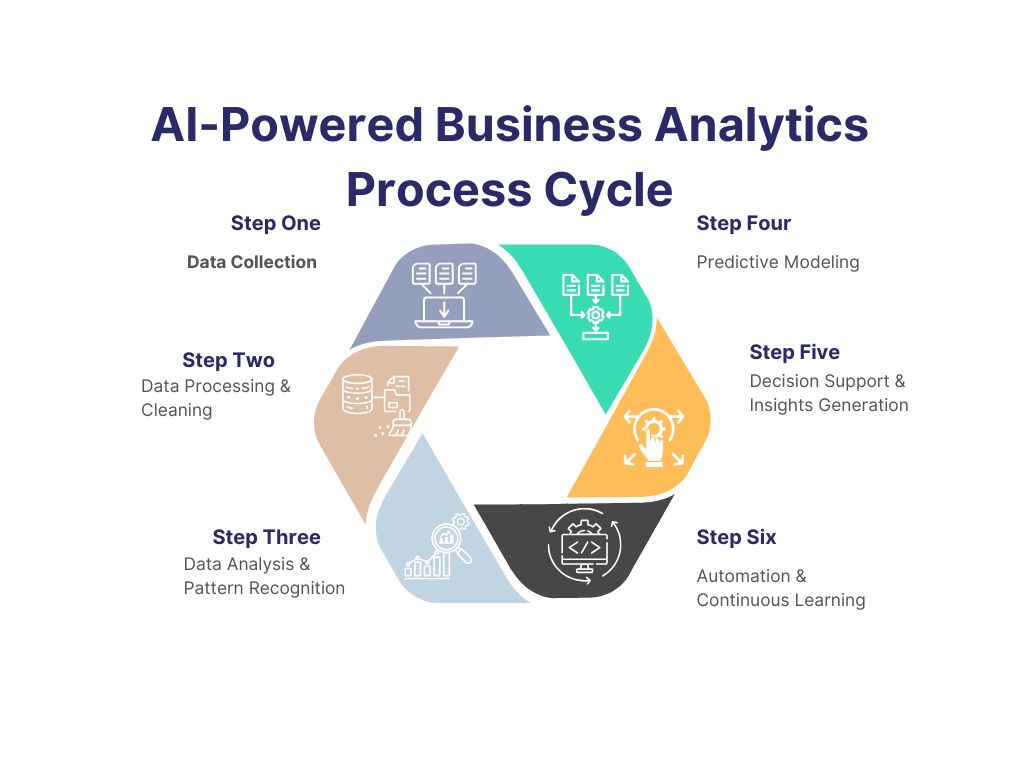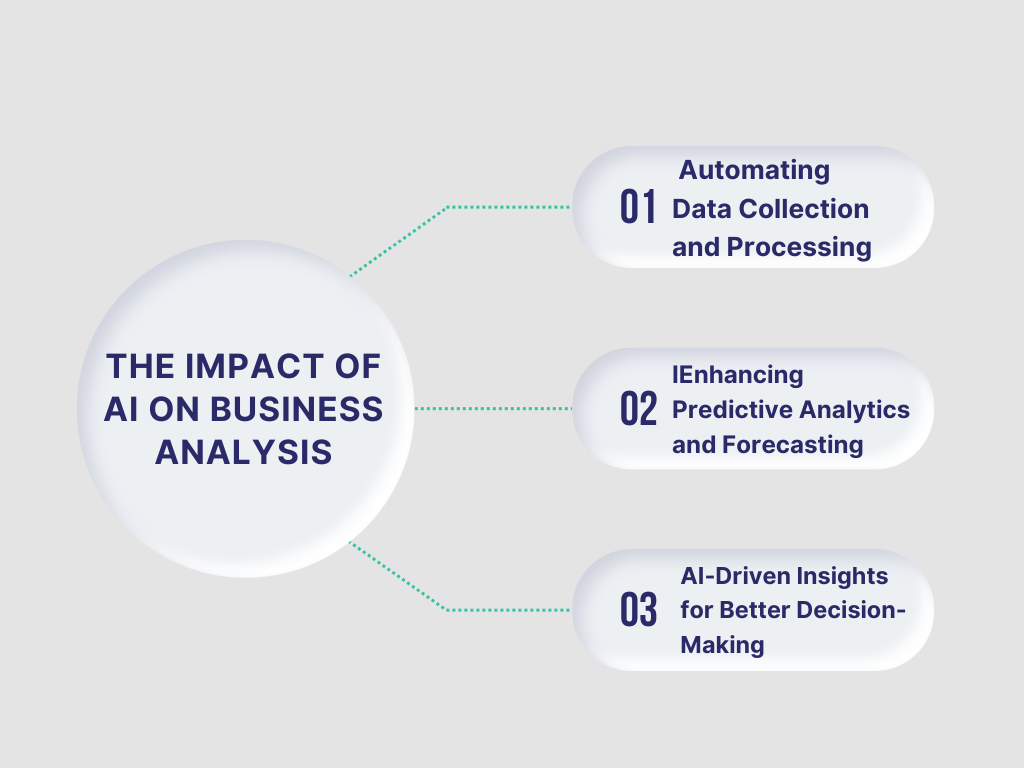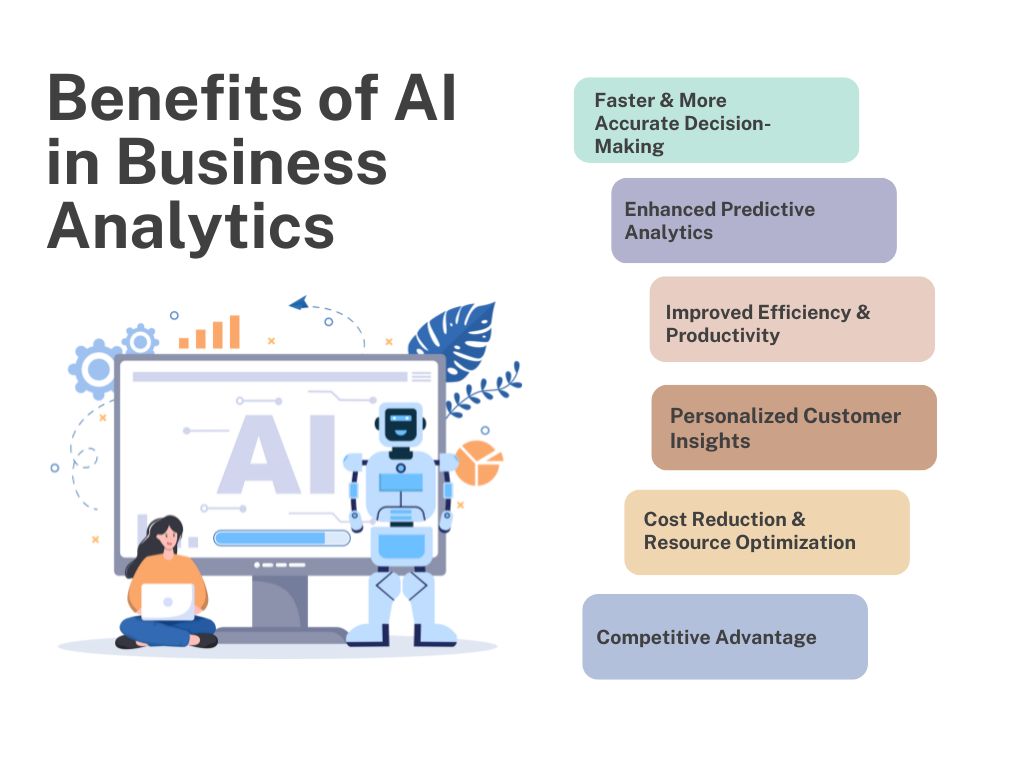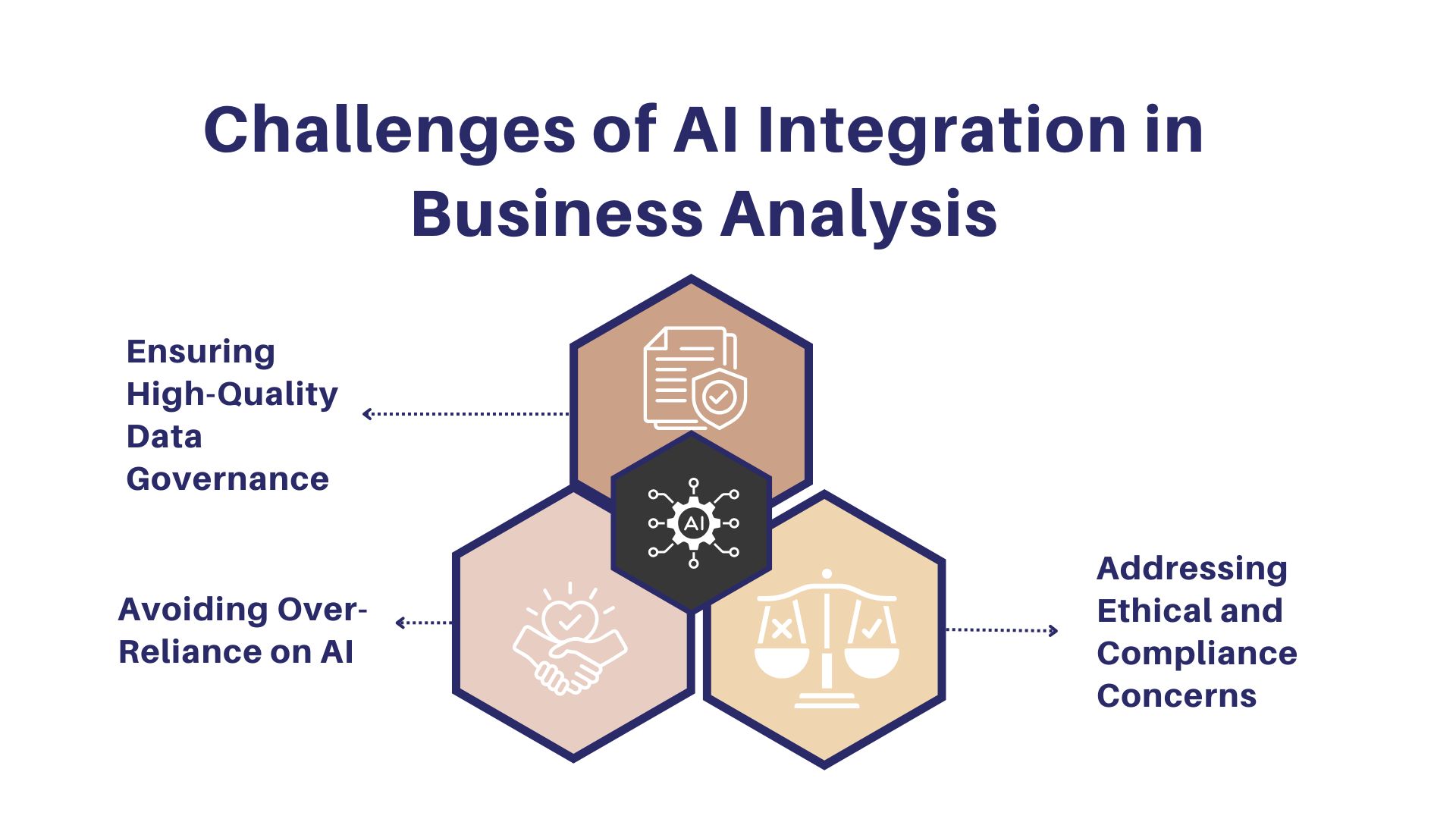AI is transforming business analytics with automation, smarter decision-making, and predictive insights. Discover top AI tools, challenges, and future trends
Artificial intelligence (AI) is changing the way businesses analyze data, make decisions, and predict future trends. Traditionally, business analysts relied on manual data collection, spreadsheets, and static reports to extract insights. However, with the rise of AI in business analytics, these tasks have been automated, enabling analysts to focus more on strategic problem-solving and decision-making.
Why is AI Transforming Business Analytics?
In today’s data-driven world, organizations deal with huge volumes of data every day. AI has the capability to process this data at scale, recognize patterns, and generate actionable insights in real-time. This means businesses can now:
- Make data-driven decisions faster and more accurately.
- Improve forecasting and risk management.
- Enhance customer experiences through personalized recommendations.
But what is business analytics in AI? It refers to the integration of machine learning, natural language processing, and business intelligence tools to automate data analysis and decision-making processes.
This blog will explore the impact of AI on business analysts, key AI technologies, the challenges of AI adoption, and the future of AI in business analytics. If you’re looking to improve your AI business analytics strategy, this guide will help you understand how to leverage AI tools for business analysts to drive better results.
The Impact of AI on Business Analysis
AI is revolutionizing business analysis by automating complex processes, improving accuracy, and enhancing the ability to interpret large datasets. Here’s how AI is making a difference in business analytics:
1. Automating Data Collection and Processing
One of the biggest pain points for business analysts has always been managing large volumes of data. AI simplifies this process by:
- Extracting data from multiple sources such as emails, PDFs, databases, and cloud storage.
- Cleaning and organizing data to remove duplicates and inconsistencies.
- Identifying patterns and correlations that humans might overlook.
With AI-powered business analytics AI tools, analysts no longer need to spend hours manually collecting and sorting data. AI enables faster processing, allowing businesses to focus on using insights rather than gathering them.
2. Enhancing Predictive Analytics and Forecasting
AI business analytics tools improve forecasting by analyzing real-time and historical data to provide accurate future predictions. Unlike traditional forecasting methods that rely on past trends, AI uses machine learning algorithms to adjust predictions based on current market conditions.
For example, AI can:
- Predict customer demand and sales patterns.
- Detect fraudulent transactions in financial institutions.
- Optimize pricing strategies using dynamic pricing models.
AI-powered impact model data analytics helps businesses stay ahead of market changes and make proactive decisions instead of reactive ones.
3. AI-Driven Insights for Better Decision-Making
AI doesn’t just process data—it provides actionable insights that help businesses make better decisions. With AI for business intelligence, companies can:
- Analyze customer behavior to personalize marketing campaigns.
- Identify inefficiencies in supply chain and operations.
- Improve risk assessment by predicting potential business threats.
By leveraging AI tools for business analytics, organizations can make faster, smarter, and more accurate decisions with minimal human effort.
Key AI Technologies Transforming Business Analysis
Several AI-driven technologies are shaping the future of business analytics. Here are the most impactful ones:
1. Machine Learning for Advanced Data Analytics
Machine learning (ML) is a core component of business analytics and AI. ML algorithms continuously learn from data and improve over time, allowing businesses to:
- Identify trends and patterns that humans might miss.
- Improve customer segmentation and targeting.
- Enhance fraud detection and cybersecurity.
2. Natural Language Processing (NLP) for Data Interpretation
NLP enables AI systems to analyze text-based data and extract meaningful insights. AI in business analytics now allows:
- Automated customer sentiment analysis from social media, emails, and surveys.
- Automatic report generation without human intervention.
- Real-time insights from unstructured data sources.
3. AI-Powered Business Intelligence Tools
The rise of AI for business analysts has led to the development of business intelligence tools that integrate AI capabilities:
- Power BI AI – Generates interactive dashboards and predictive reports.
- Tableau AI – Provides automated data visualizations and insights.
- Google Cloud AI – Offers advanced machine learning capabilities for businesses.
These tools empower business analysts to generate insights quickly and communicate data visually.
How AI in Business Analytics Works
AI in business analytics automates data collection, analyzes trends, and generates actionable insights to improve decision-making. It follows a structured process that includes data gathering, processing, analysis, prediction, and reporting.
AI-Powered Business Analytics Process Cycle
- Data Collection – AI gathers data from multiple sources, including databases, cloud storage, customer interactions, and social media.
- Data Processing & Cleaning – AI ensures the data is accurate, removing duplicates and correcting inconsistencies.
- Data Analysis & Pattern Recognition – Machine learning algorithms analyze historical and real-time data to identify trends and correlations.
- Predictive Modeling – AI forecasts future outcomes based on past patterns and external factors.
- Decision Support & Insights Generation – AI-powered tools provide recommendations for business strategy, financial planning, and customer targeting.
- Automation & Continuous Learning – AI continuously improves its predictions by learning from new data and user interactions.
Benefits of AI in Business Analytics
1. Faster & More Accurate Decision-Making
AI reduces human errors and provides real-time insights, allowing businesses to make informed decisions quickly.
2. Enhanced Predictive Analytics
AI-powered impact model data analytics enables businesses to forecast trends, detect risks, and improve market strategies.
3. Improved Efficiency & Productivity
With AI automating repetitive tasks, analysts can focus on strategic problem-solving and decision-making.
4. Personalized Customer Insights
AI helps businesses analyze customer behavior, allowing them to deliver personalized experiences and targeted marketing campaigns.
5. Cost Reduction & Resource Optimization
AI minimizes operational costs by automating manual processes and optimizing resource allocation, leading to higher profitability.
6. Competitive Advantage
Organizations leveraging AI for business intelligence gain a competitive edge by making data-driven, proactive decisions faster than their competitors.
Challenges of AI Integration in Business Analysis
While AI is revolutionizing business analytics, organizations must overcome several challenges to successfully implement it:
1. Ensuring High-Quality Data Governance
AI models rely on high-quality data. If the data is inaccurate, AI-generated insights will also be flawed. Businesses must:
- Implement strong data governance AI policies.
- Use AI-powered data cleansing tools to improve accuracy.
- Continuously monitor AI predictions to prevent biases.
2. Avoiding Over-Reliance on AI
AI is powerful, but it shouldn’t replace human expertise. Business analysts must:
- Interpret AI-driven insights with human judgment.
- Validate AI findings before making business decisions.
- Combine AI automation with strategic human thinking.
3. Addressing Ethical and Compliance Concerns
AI introduces new ethical and compliance challenges that businesses must navigate:
- Ensuring AI does not introduce bias into decision-making.
- Complying with data privacy laws like GDPR and CCPA.
- Maintaining transparency in AI-generated recommendations.
The Future of Business Analytics with AI
The future of business analysis is AI-driven, but it will still require human expertise. What is the future of business analytics with AI?
- AI will collaborate with business analysts rather than replace them.
- Self-learning AI models will improve real-time data analysis.
- AI-powered decision support systems will automate routine business decisions.
Businesses that embrace AI early will have a competitive advantage and lead innovation in their industries.
Conclusion
AI is reshaping the future of business analysis by automating data processing, enhancing insights, and improving decision-making. Companies that leverage AI tools for business intelligence will gain a competitive advantage and drive better business outcomes.
Are you ready to integrate AI into your business analytics strategy? The future is AI-powered—don’t get left behind!
Frequently Asked Questions (FAQs)
1. What is business analytics in AI?
Business analytics in AI refers to the use of artificial intelligence in data analysis to automate data collection, identify trends, and improve decision-making. AI helps businesses process large amounts of data efficiently, reducing manual effort and enhancing insights.
2. Which AI is best for business analysts?
Some of the best AI tools for business analysts include:
- Power BI AI – For real-time data visualization and insights.
- Tableau AI – For AI-powered business intelligence and analytics.
- Google Cloud AI – For machine learning-based data processing.
- IBM Watson Analytics – For predictive analytics and AI-driven decision-making.
These tools help business analysts work faster, smarter, and more efficiently.
3. How does AI improve business intelligence?
AI improves business intelligence (BI) by:
- Automating data collection and analysis, reducing human errors.
- Enhancing predictive analytics, helping businesses forecast future trends.
- Providing deeper insights by identifying patterns in large datasets.
- Improving reporting and decision-making through AI-driven dashboards and reports.
4. What are the top AI tools for business analytics?
The best AI business analytics tools include:
- Google AI for Business Analytics – Cloud-based AI solutions for enterprises.
- SAP Analytics Cloud AI – AI-driven business intelligence and reporting.
- Salesforce Einstein Analytics – AI-powered CRM and business intelligence.
- Alteryx AI – AI for data preparation, machine learning, and automation.
These tools allow businesses to make data-driven decisions with precision.
5. How can businesses prepare for AI-driven analytics?
Businesses can prepare for AI-powered business analytics by:
- Training employees to use AI-driven analytics tools.
- Integrating AI-powered BI platforms into their workflows.
- Investing in machine learning models to automate data processing.
- Ensuring high-quality data governance for better AI predictions.
By adopting AI-driven analytics early, businesses can gain a competitive advantage in the market.
6. What are the biggest challenges in AI adoption for business analysis?
Some of the key challenges in adopting AI for business intelligence include:
- Data Quality Issues – Poor data can lead to inaccurate AI predictions.
- Over-Reliance on AI – AI should support decisions, not replace human expertise.
- Ethical Concerns – AI must be free from bias and ensure transparency.
- Compliance with Data Privacy Regulations – AI systems must align with GDPR, CCPA, and other privacy laws.
Overcoming these challenges is key to maximizing AI’s potential in business analytics.
7. What is the future of business analytics with AI?
The future of AI in business analytics includes:
- AI-powered automated decision-making to reduce human workload.
- Self-learning AI models that continuously improve analysis.
- Integration of AI with IoT and big data analytics for real-time insights.
- More personalized AI recommendations for business strategies.










